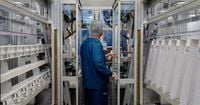Novo Nordisk, the Danish pharmaceutical powerhouse renowned for its blockbuster weight-loss drugs Ozempic and Wegovy, has announced a sweeping restructuring plan that will see 9,000 jobs eliminated worldwide—a staggering 11% of its global workforce. The move, revealed on September 10, 2025, marks the largest layoff in Denmark’s history and signals a dramatic response to mounting competitive and financial pressures that have beset the company over the past year.
The layoffs, which will impact 5,000 employees in Denmark alone, are set to begin immediately, with affected staff receiving notifications over the coming months, in accordance with local labor regulations. Novo Nordisk, headquartered just outside Copenhagen, currently employs 78,400 people around the globe. The company expects the restructuring to save approximately 8 billion Danish kroner (about $1.25 billion) annually by the end of 2026—a move designed to “simplify Novo’s structure and redirect resources toward growth in diabetes and obesity,” according to Michael Novod, head of equity research for Denmark at Nordea Bank, as quoted by Reuters.
This bold maneuver comes just weeks after Maziar Mike Doustdar took the reins as CEO, succeeding Lars Fruergaard Jorgensen in August 2025. Doustdar wasted little time making his mark, emphasizing the need for Novo Nordisk to become “faster and more agile.” In a statement announcing the layoffs, he said, “Sometimes the hardest decisions are the right ones for the future we're building. I'm confident that this is the right thing to do for the long-term success of Novo Nordisk.”
The company’s meteoric rise began in 2021, when Wegovy became the first highly effective obesity drug approved in the United States. This breakthrough led to explosive growth, with Novo nearly doubling its workforce over five years and, at its peak, achieving a market capitalization of $650 billion—surpassing Denmark’s entire annual GDP. However, the company’s fortunes have reversed sharply. As of September 2025, Novo Nordisk’s market cap has plummeted to roughly $181 billion, and its shares have lost nearly 46% of their value since the start of the year, with some sources noting a decline as steep as 58% over the past twelve months.
Several factors have contributed to Novo’s recent struggles. Chief among them is intensifying competition in the lucrative obesity and diabetes markets. U.S. rival Eli Lilly has surged ahead, with its GLP-1 drugs Zepbound and Mounjaro posting extraordinary sales gains. According to Eli Lilly’s second-quarter 2025 earnings, Mounjaro generated $5.2 billion in revenue, up 68% year-over-year, while Zepbound reached $3.4 billion, a 172% jump. Earlier this year, Zepbound overtook Wegovy in weekly U.S. prescriptions, although Novo Nordisk managed to narrow the gap over the summer.
But it’s not just traditional competitors causing headaches. Novo Nordisk has also been grappling with the proliferation of compounded, non-FDA-approved versions of its semaglutide-based drugs. Back in 2022, the U.S. Food and Drug Administration declared a shortage of GLP-1 medications, which allowed pharmacies to legally produce compounded alternatives. Even after the FDA lifted the shortage notice in May 2025 and imposed new restrictions, compounded versions continue to siphon off market share. Novo has filed over 130 lawsuits against companies selling these products, but the financial impact remains significant. During his final earnings call, former CEO Jorgensen admitted that the market for compounded semaglutide in the U.S. is now “equal” in size to Novo’s own GLP-1 business.
The company’s response to these challenges has been multifaceted. In addition to the mass layoffs, Novo Nordisk has imposed a hiring freeze on non-essential roles and is redirecting savings into research and development, manufacturing expansion, and improving global patient access. The company’s fourth-quarter savings alone are expected to reach at least 1 billion Danish kroner ($157 million), earmarked for these strategic investments.
Still, the financial toll is immediate. The restructuring will incur a one-time cost of 8 billion kroner (about $1.3 billion), which will dampen Novo’s 2025 operating profit growth by about 6%. The company has revised its profit growth forecast for the year to between 4% and 10%, down from an earlier estimate of 10% to 16%. In July, Novo Nordisk lost $70 billion in market value after issuing a profit warning, and analysts at Bank of America now expect a fourth profit warning when third-quarter results are announced in November.
Doustdar, for his part, has been candid about the need for change. “Our markets are evolving, particularly in obesity, as it has become more competitive and consumer-driven. Our company must evolve as well,” he said in the company’s press release. He stressed the importance of instilling a performance-based culture and prioritizing investment in the company’s leading therapy areas: “This means instilling an increased performance-based culture, deploying our resources ever more effectively, and prioritizing investment where it will have the most impact — behind our leading therapy areas.”
The company has not specified which business units will bear the brunt of the cuts, but insists that its commitment to rare diseases and other therapeutic areas remains intact. “We have ambitious plans within rare disease, with several exciting product launches over the coming years,” a Novo Nordisk spokesperson told industry media.
For employees and investors alike, the announcement is a stark reminder of the volatility that can accompany rapid growth in the pharmaceutical sector—especially when blockbuster products attract both intense consumer demand and cutthroat competition. Lukas Leu, a portfolio manager at ATG Healthcare and Novo Nordisk shareholder, summed up the challenge: “They need to reignite investor confidence with an appealing growth story for the future. The obesity market was misjudged. It’s much more consumer-driven than anticipated, and Novo expanded organizational complexity too quickly.”
Despite the turbulence, Novo Nordisk is betting that this painful restructuring will position it for renewed success. The company is pressing ahead with new product launches, including a pill version of Wegovy, and is exploring additional health benefits within its GLP-1 portfolio. Doustdar has laid out three clear priorities: focus on diabetes and obesity, strengthen commercial execution, and realign the company’s cost base. “We will secure Novo Nordisk’s leadership in diabetes and obesity and continue our mission to defeat chronic disease,” he pledged in a recent statement.
The coming months will test whether these drastic measures can restore Novo Nordisk’s momentum and help it reclaim its former stature in the fiercely competitive weight-loss and diabetes markets. For now, the company—and thousands of its employees—face a period of uncertainty and transformation.



